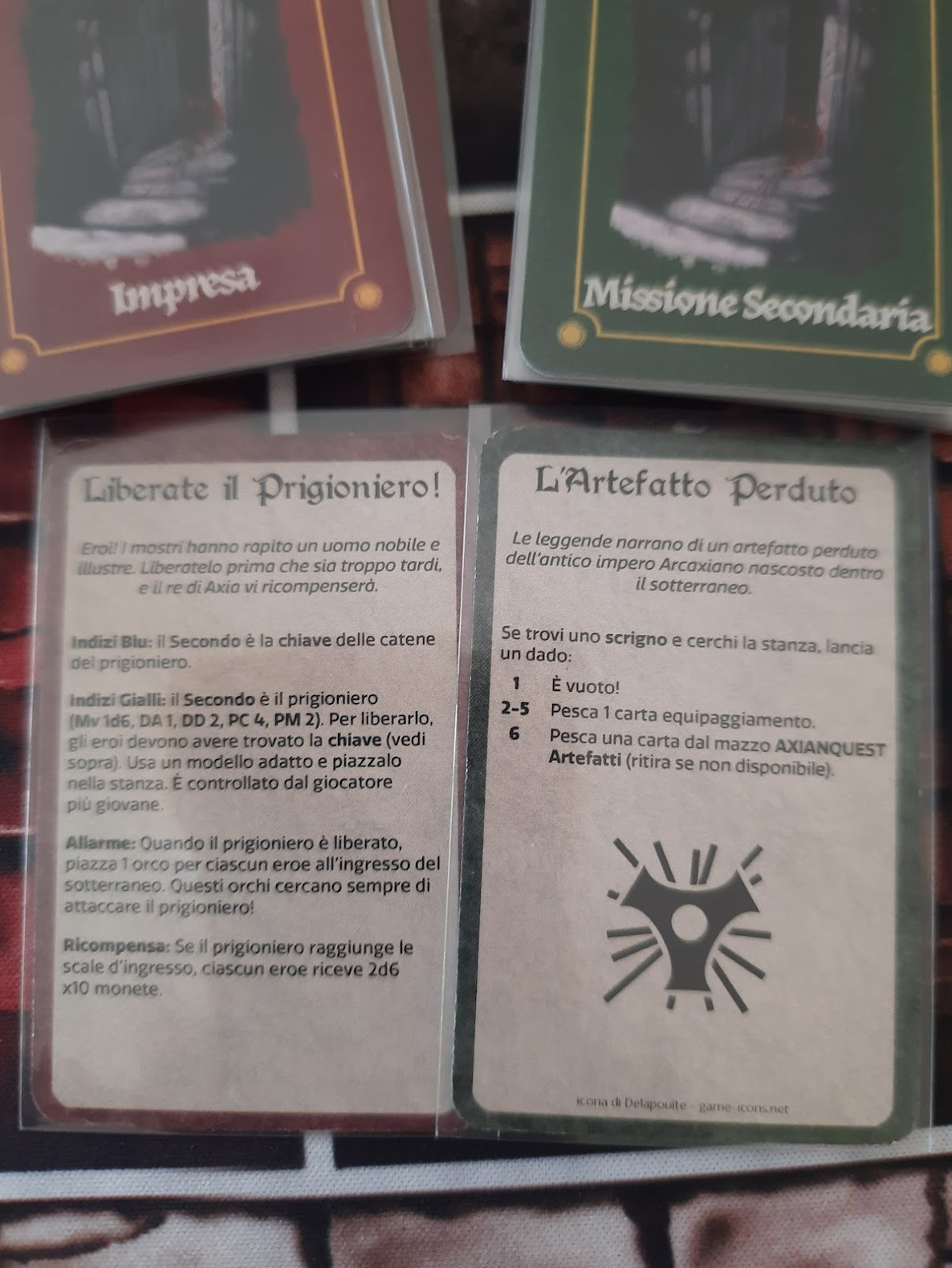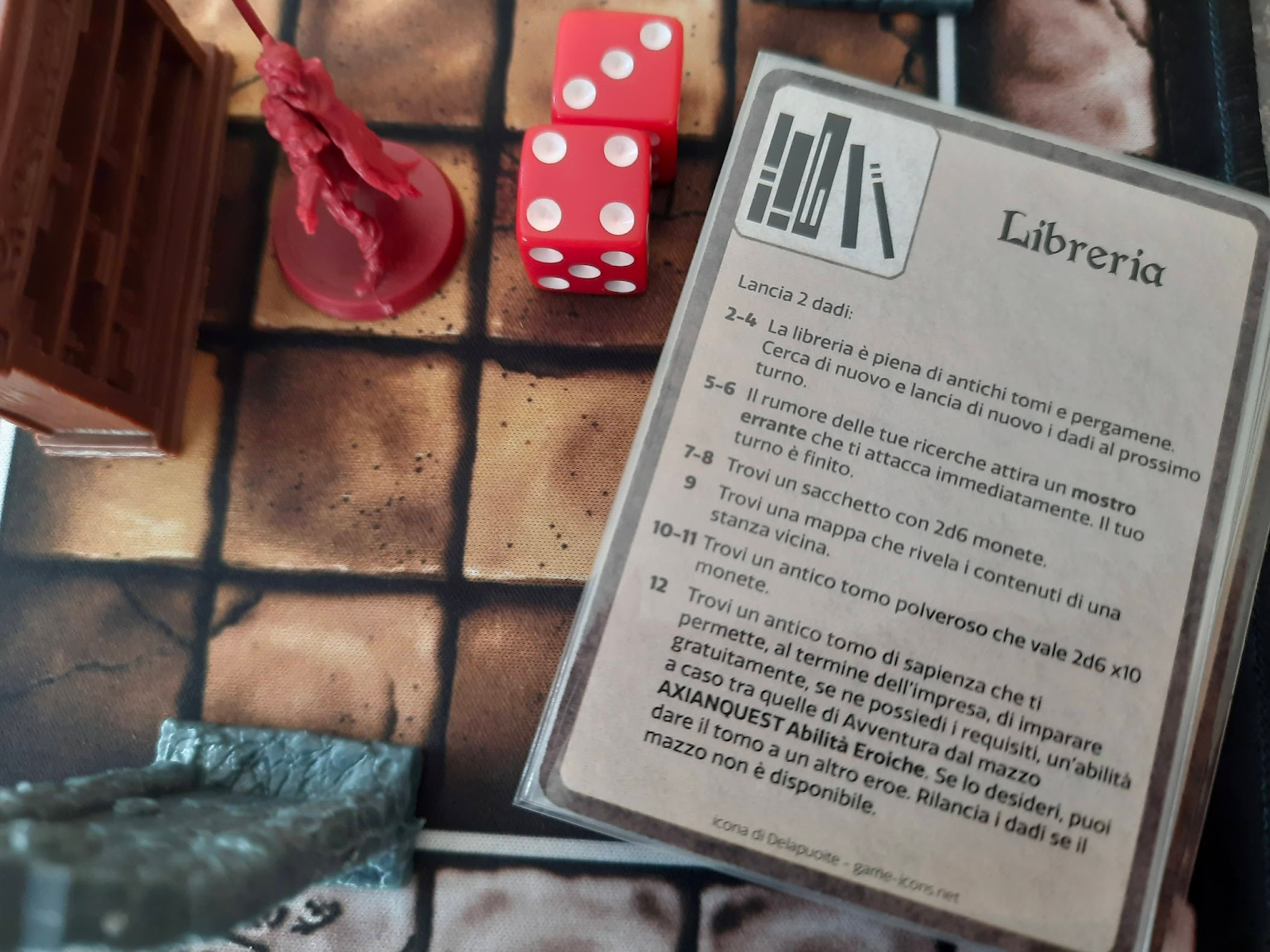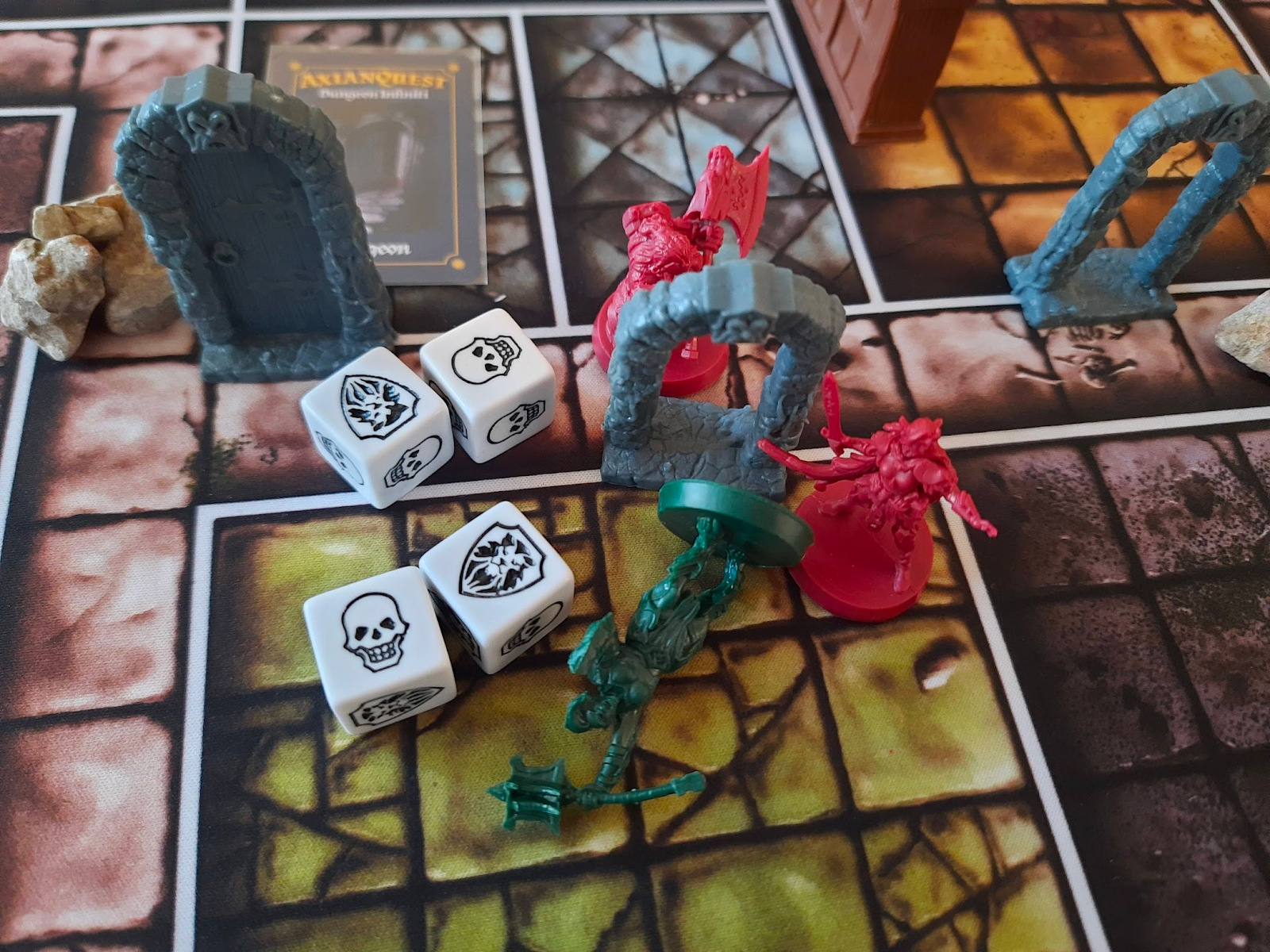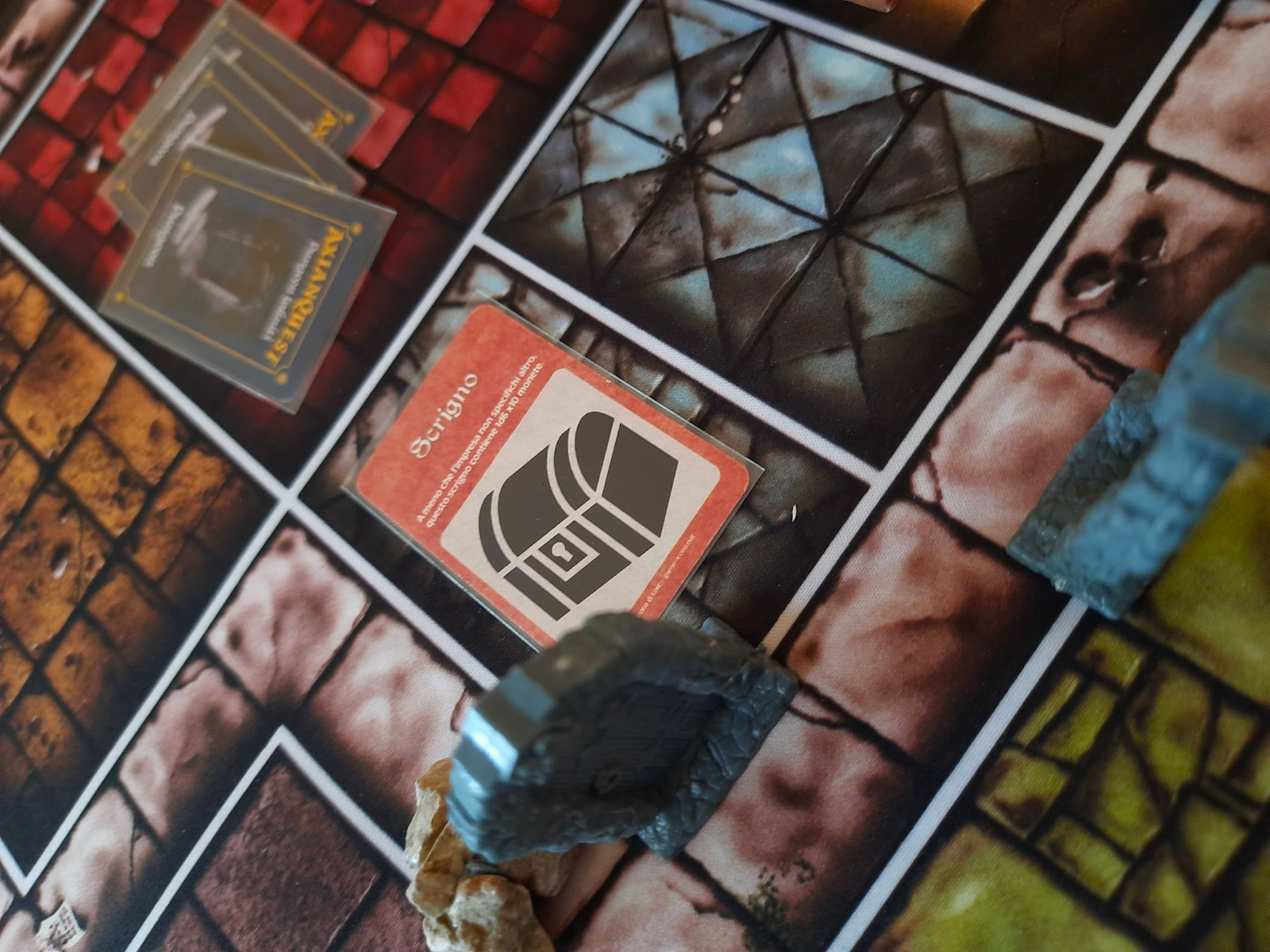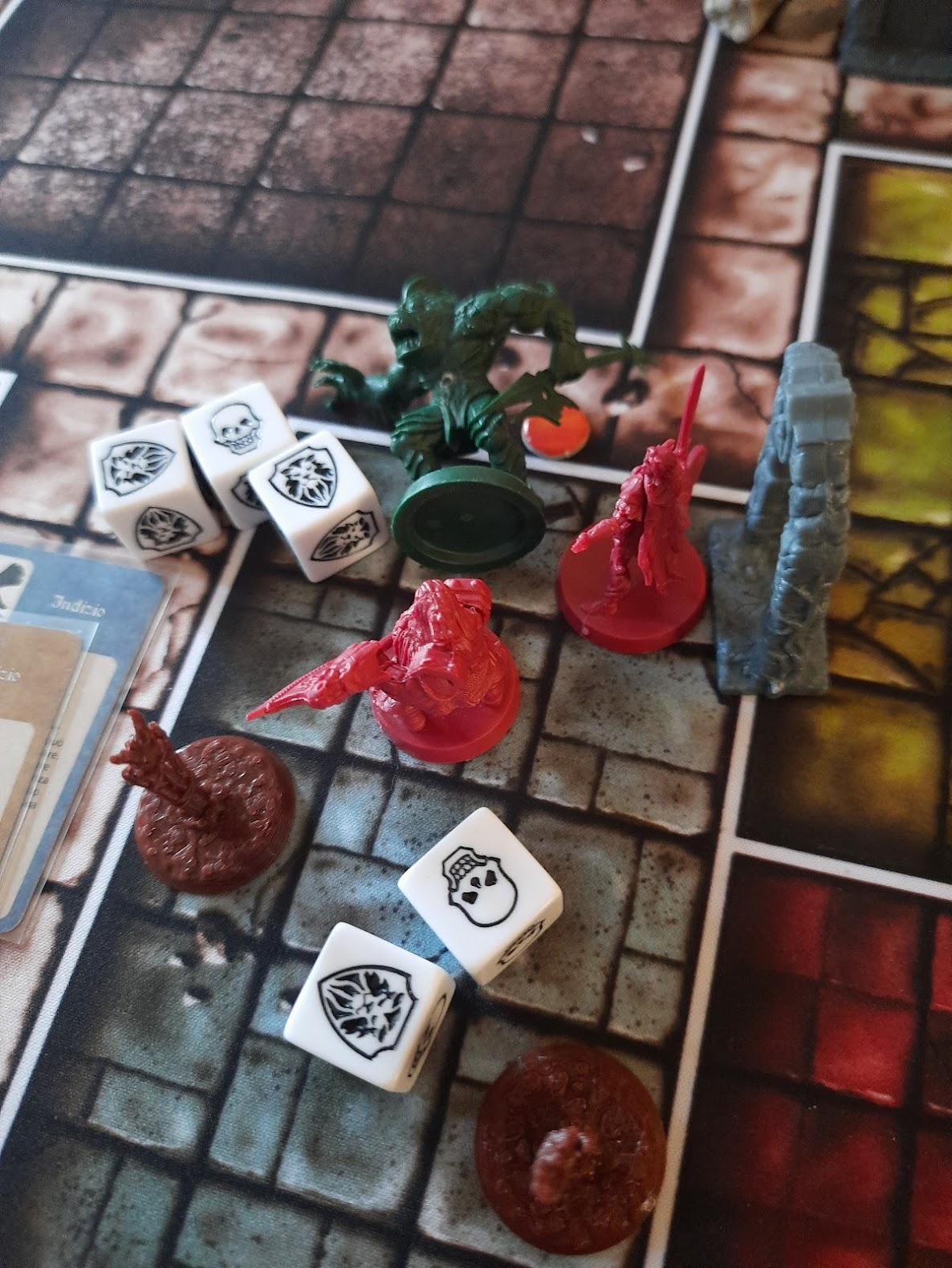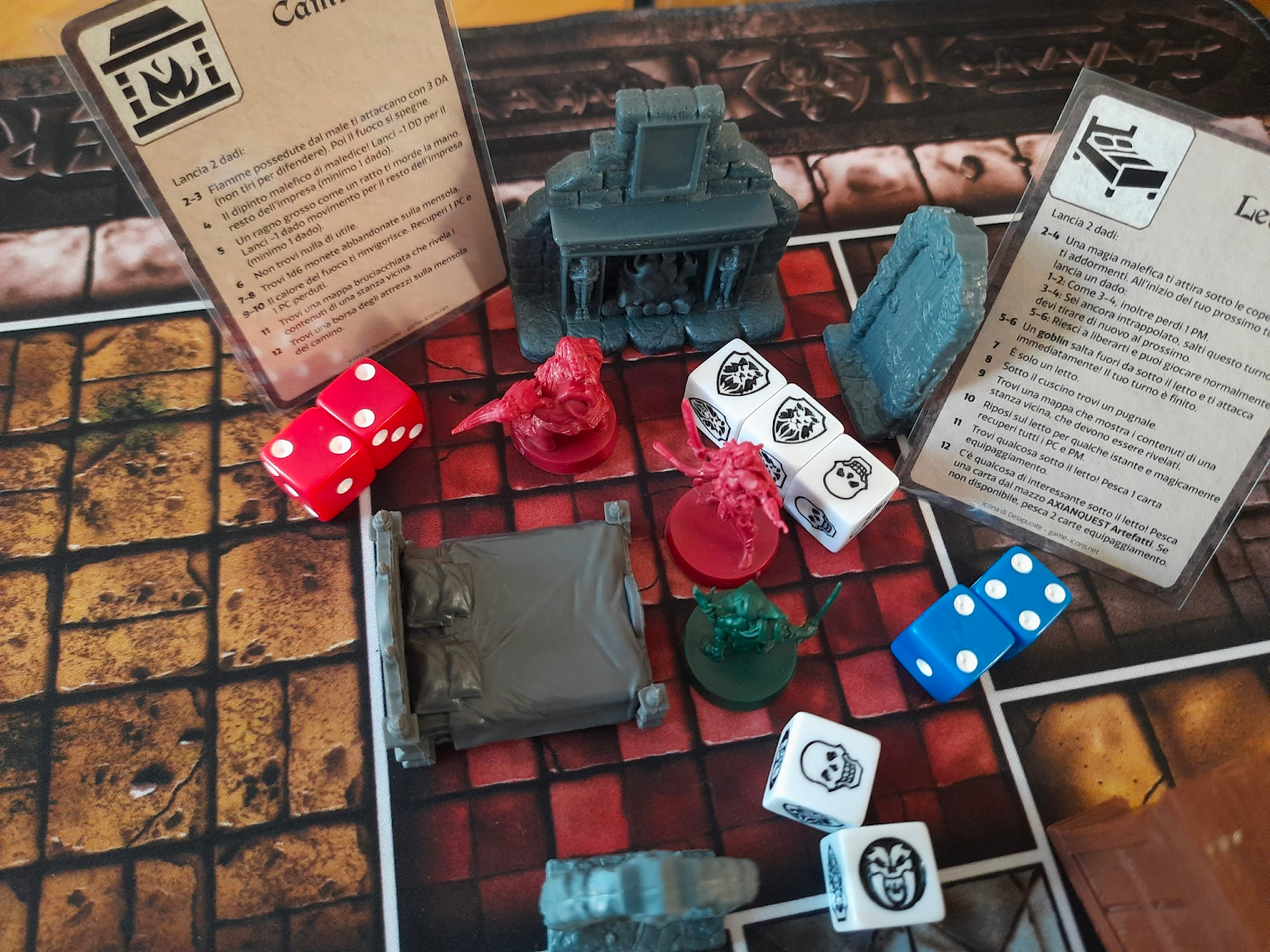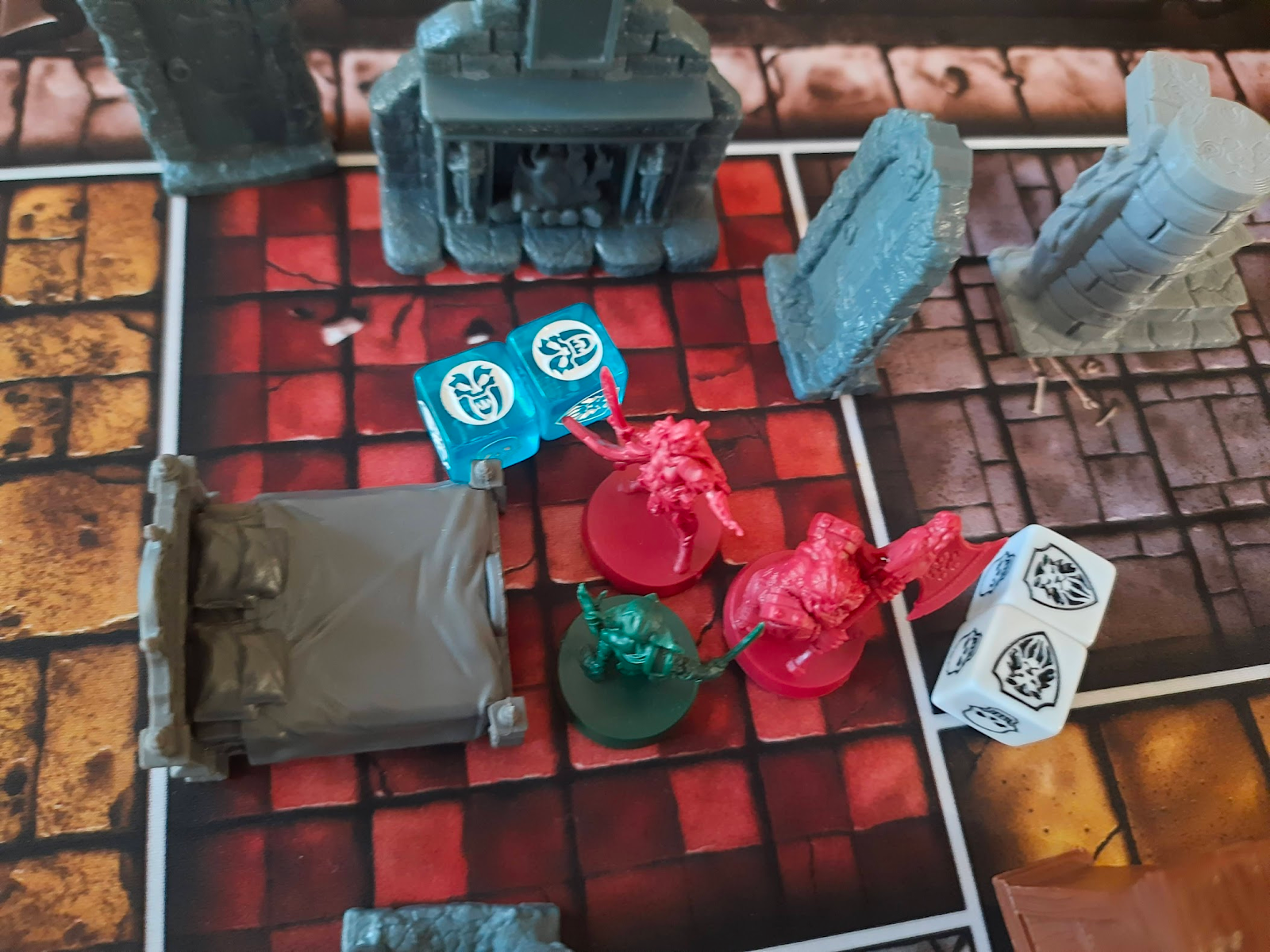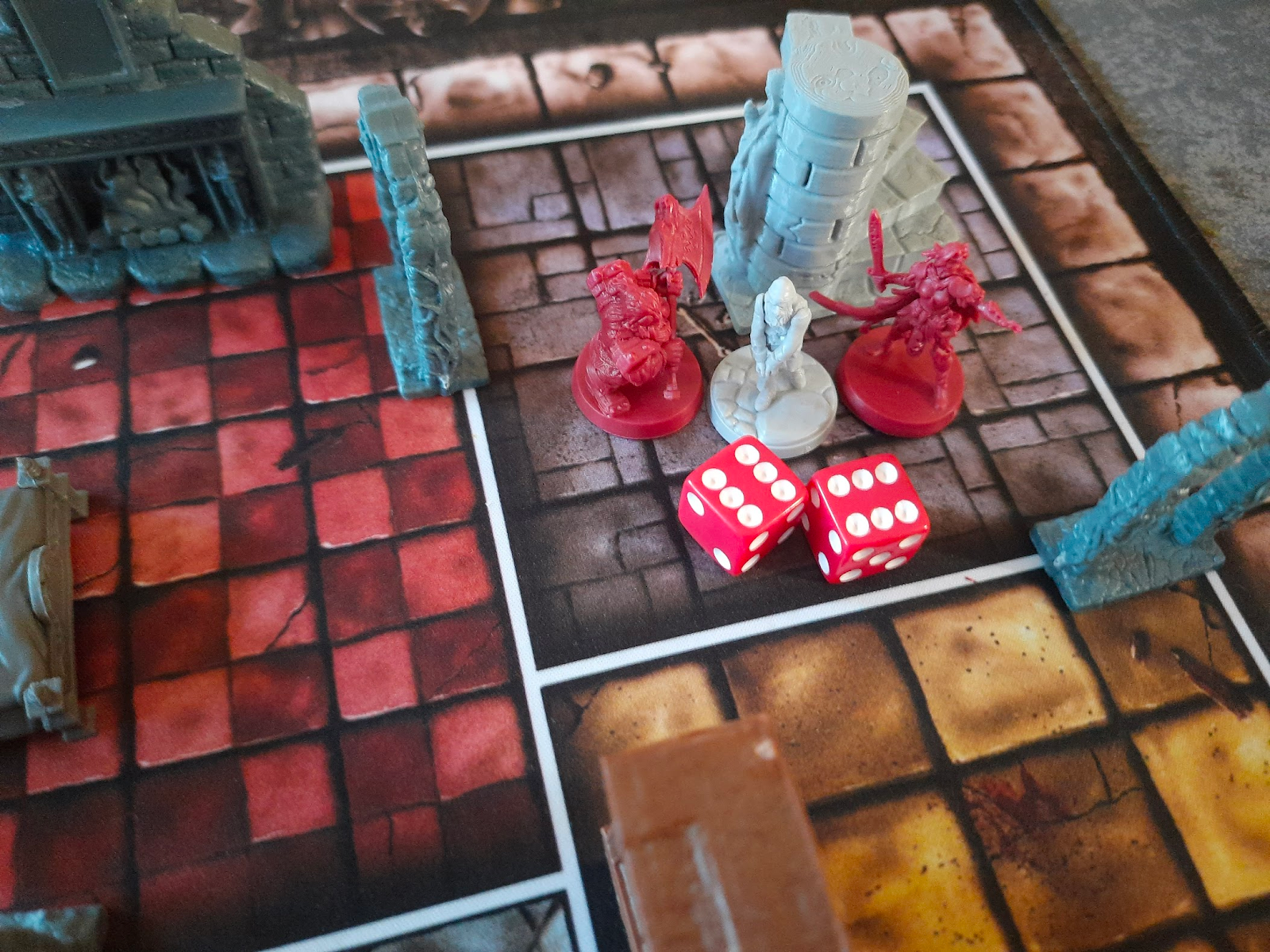...for those who somehow don't know: in the last few months I've published the AxianQuest deck series, which consists of seven unofficial decks that expand the HeroQuest board game.
The decks been a huge success, with over 3000 decks sold so far and enthusiastic reviews both on the dtrpg product pages and several youtube video reviews (I'll just mention that The Dungeon Dive review titled "HeroQuest + AxianQuest Infinite Dungeons = the way it should be played"!!).
For those interested, the full series of decks is available as a bundle, or individually.
So today I decided to play a game using the Infinite Dungeon deck, which allows solo gmless play, and the Furniture deck... and to make a full report of the game. So here it comes!
(The full game, plus taking 50 pics, took about 80 minutes. Playing alone really speeds the game up, and usually allows me to play three or for quests in one evening).
ABOUT THE CARDS IN THE PICS: For this game I've used the Italian version of the decks, but they are available in English too, of course.
The Set-Up
The Infinite Dungeon game allows you to play a gmless game with 1 to 5 heroes, with self-adjusting difficulty.
Play with 1 hero is quite hard (and can be extremely hard if that one hero is the wizard...); with 2 or more it gets... reasonably hard.
I want to play an easy game so I choose to play with the elf and the dwarf. These are, in my opinion, the best combo for a 2-hero game, as the dwarf takes care of most traps, and the elf offers decent support and healing. I pick Earth spells, of course.
I grab the Infinite Dungeon rulesheet, and then I set up the hero sheets and the decks I want to use; On the left is the Furniture deck; on the right, I've already divided the Infinite Dungeon deck, forming a pile with the dungeon cards, one with the Quest cards and one with the Side Quest cards.
Next, I draw one Quest card and one Side Quest card.
The Quest is a classic Rescue the Prisoner scenario. We will call him "Sir Pepys". The Side Quest (which is a rumor and might prove false...) tells me that if I find a chest, it might contain an artifact!
Time to prepare the Dungeon deck (i.e. the the dungeon cards that will end on the board and constitute the rooms' contents). Following the rulesheet, I first remove the four Clue cards from the dungeon cards:
Then, I check the rulesheet again and see that when playing with 2 heroes I must form the Dungeon deck with 11 random dungeon cards, + d6 more dungeon cards, + the 4 Clue cards. I roll the die and it's 4 more cards, so this is what constitutes the dungeon deck (19 cards total):
I shuffle them all together, and follow the rulesheet for the next step: I roll a die for the big central room and another one for the two small rooms. If I get a skull, I must place cards on them. The big room gets no cards (if I had rolled a skull, I would have placed one card per hero on it); one of the small rooms gets one card (the small rooms always get just 1 card, regardless of how many heroes are playing).
Time to place all the remaining cards in the dungeon deck (18 cards). The rulesheet tells me that for a 2-hero game I must place 3 cards on any room I like (except the big one and the small ones):
The final step of the set-up is to choose a starting room, and place the stairs, heroes, and two closed doors (they must lead to a room with cards on it, or to a corridor), so this is how the board looks like in the end:
The Quest for Sir Pepys (and possibly a mysterious artifact!)
I choose that the dwarf plays first throughout the quest, and I use the rule that when there are no monsters on the board heroes move 8 squares without rolling their movement dice.
The dwarf heads for the door to the south and opens it. Movement pauses and I turn face-up the cards to see what's in the room:
Having the dwarf go first was a good idea: the room contains (left to right): a bookshelf, and two traps!
Traps in Infinite Dungeon work a bit differently from the standard game. They are always triggered by opening the door. This ensures the "surprise element" in a very quick, easy way. Also, heroes are always assumed to be actively searching for traps, so when you find a trap, like our poor dwarf now, you have a chance to disarm them before they go off.
The purple one is a fiery trap that attacks all heroes in the room with 2 combat dice. Purple trap cards are "magic traps" so the hero at the door has a chance to disarm it by rolling less than his Mind Points. I roll a 4 so both the elf and the dwarf are attacked...
The red trap is a death log trap, attacking the hero at the door and anyone behind him with 2 dice. This is a "regular" mechanical trap, so the dwarf has a chance to disarm it before it's triggered using his regular dwarf skill. I roll a skull so at least he avoids the death log!
I roll the combat dice for the fiery trap and I'm quite lucky, only the dwarf suffers 1 BP of damage (neither the death log nor the fiery trap allow for defense rolls).
Remember I decided to use the Furniture deck? The elf enters the new room to Search the bookshelf, so I grab the Bookshelf card from the deck and roll 2d6 to see what he finds. I roll a 7 and the card says she finds 2d6 coins. Another roll and the result is 4 coins. Not particularly exciting, but not too bad either. (On a 10 or 11 I would have found 2d6 x10 coins...).
On his turn, the dwarf opens the next door. When a hero opens a door to a corridor, the player can choose to place one or two closed doors to rooms with face-down cards. I choose to place 2. For each door, I must also place a wall block. These cannot block the hero's path to the doors. So this is how the corridor looks like:
On her turn, the elf moves along and opens the door of the southern room. She finds monsters and a clue!
The player opening the door gets to choose where to place the room's contents, and also places a new door, so this is how the room looks like:
For the clue, I use a totem figure I got from a creator on Etsy.
The elf still had 2 movement points left, so she charges one of the orcs! ...and this is when I realized I should have cast my rock skin spell... Fortunately, she takes the orc out immediately...
...but there are 2 more in the room, and after the elf it's their turn (remember, I chose to have the dwarf be the first hero).
In Infinite Dungeon, monsters with no ranged attack and no spells always attack the nearest hero, so postioning is important. In this room, it means both remaining orcs will go for the poor elf. She loses 1 BP to first one, while the other completely misses her:
Now it's the heroes's turn again. Both attack, and the elf kills one.
The remaining orc tries to destroy the dwarf, but he manages to roll a perfect defense..
And then finishes her on his next turn:
With monsters gone, the elf searchers the clue.
Blue cards allow you to turn face-up 1 card from an unexplored room. I choose to turn face-up the lonely card in the small room, and I find a chest! So the rumor of the side quest might actually be true!!
I also place the clue card nest to the quest card, so as to remind me that I've already found one. The quest cards explains that the second blue clue I'll find will represent the keys to the prisoner's chains.
While excited for the chest, I decide to keep exploring to the south, so the dwarf opens the new door and this is what's in the room:
I'm quite lucky, as I find TWO clues. That's my second blue clue, so it's the keys! And of course there's an Abomination guarding the keys...
The dwarf charges in and wounds the monster:
while the elf fails her attack
The abomination attacks and wounds the dwarf...
...who strikes back and finishes it.
The room is now safe and the heroes grab the keys and also examine the clues. The blue one represents the keys and also allows me to reveal 1 card; the yellow one allows me to reveal 2.
I choose to turn face-up the cards in the rooms to the north. (for each clue effect I must choose a room with no revealed card, so I must choose 2 different rooms).
The quest card tells me that the second yellow clue I find is the prisoner, so I had hoped to find it inside one of those rooms, but no luck. Where's poor sir Pepys?
I decide to head north (on my way I finally remember to cast stone skin on the elf). The dwarf opens the chest oping to find a legendary artifact. The die says "not today". I roll 1 and the chest is empty.
The two move one to explore the room to the north. The dwarf opens the door and finds an Abomination, a fireplace, and a torture rack...
...but I find it weird to have a cosy fireplace next to a torture rack, so I swap the latter for a cosy bed!
The dwarf charges in and wounds the monster
But the Abomination blocks the elf's attack...
And strikes the dwarf for 2 unblocked BP!
In shock, the dwarf fails to strike back; the elf, however, kills it off.
So it's time to search the furniture!
The dwarf examines the fireplace and rolls a 4: the evil painting on the mantlepiece curses him! He will roll -1 defense die for the rest of the quest.
The elf searches the bed and a sneaky goblin jumps out from underneath it, attacking her immediately!
The rock skin spell protects her alright, and then it's the little guy's turn again, but he misses.
And then both heroes miss him with their attacks!
The little monster proceeds then to stab the elf for 2 BP, which also break her rock skin spell!
After another miss by the dwarf, the elf finally puts it down. The little fellow did a lot of damage though!
I decide to open the door to the north, and to place 2 doors to the 2 rooms left to explore. Sir Pepys must be close! I place the doors and wall blocks and, as per rulesheet, I roll a die for each door to see if the doors are guarded by monsters. I'm lucky: no skulls, no monsters.
I proceed to the room to the south, because it has 3 face-down cards, while the other only has 2, which means I have better chances of finding Sir Pepys there. The heroes reach the room and the dwarf opens the door, but no Sir Pepys here! A table, a weapon rack, and a zombie, which the dwarf obliterates immediately.
Which means the heroes get to search the furniture immediately with the furniture cards. A weapon rack has a high chance of yielding... weapons, so let's roll!
First goes the elf. She checks the table but only finds a rotten apple...
The the dwarf rolls 11 and finds a cool BRODESODE!
The two heroes head back north to the last unexplored room. I already knew there was a goblin card; the other two were the second yellow Clue (which, as per quest card, represents the prisoner), and a piece of furniture.
So 2 goblins guard the prisoner. The heroes storm the room and dispatch them immediately!
(I was worried the two greenskins were going to cause trouble like the one from under the bed...)
Now, the quest card also tells me that, once the prisoner is freed, the alarm is raised!
Which means one orc per hero appears in the starting room, and they will prioritize the prisoner as their target as I try to take him out of the dungeon. So there they are. Check the pick: the fastest route from the heroes to the stairs (and viceversa, for the orcs) is along the board's border... but the orcs cannot follow this path because it involves a closed door and monsters cannot open doors!
This makes me think I might have a plan, and enough time to get out without the need for a fight... But since now there are monsters on the board, heroes must roll their movement dice, so it's all uncertain... and the quest card specifies that poor Sir Pepys only rolls 1 die to move.
So the run begins, and Pepys manages to roll a 6...
...followed by a 5, but the orcs are fast and it's now clear I won't be able to avoid a fight. Both heroes are wounded (the elf only has 2 BP left!), but I still have my healing spell, and the dwarf now rolls 3 attack dice because he's found the
BRODESODE (and he only rolls 1 defense die because he was cursed by the painting...).
One orc charges the dwarf and wounds him! The second orc cannot reach him, phew -
So it's the heroes' turn again, and the dice assist them with two great rolls. Goodbye orcs! I bet Sir Pepys must be impressed with the heroes' prowess.
So the prisoner is freed, and there's only one thing left to do: get the reward!
For this quest, the card said it was 2d6 x10 coins for each hero... and I've rolled 12!!
Both the dwarf and the elf receive 120 coins.
(plus the elf found 4 more in the bookshelf, and the dwarf found a BRODESODE, so absolutely not bad for a first quest!)
Conclusion (or not?)
All in all this was a fun game!
The heroes got heavily wounded, but I still had my healing spell available. Most monsters rolled quite poorly anyway (except the terrible goblin from under the bed!).
If you've read this far, I think I can assume you've enjoyed the report as much as I've enjoyed the game. Let me know in the comments if you'd like more!
I now realize I should have taken a pic of the whole board at the end, but everything is back inside the box now...

